Oakleaf (Eichenlaub) camo
Michael Beaver, in his book "Camouflage Uniform of the Waffen-SS", created in collaboration with renowned camouflage researcher Dr. J. Borsarello, writes that the Oak camouflage appeared as a backing (colored part) under the Blurred Edge (Rauchtarn) camouflage.
As a substrate, it was also used for Platan camouflage since 1940. It had 3 colors: earth, dark foliage and bright foliage. Traditionally, for SS camouflage it had 2 scales: autumn and spring (summer).
Spring:
Earth — brown with a pink tint
Dark Foliage — dark green
Bright foliage — light green, salade green
Autumn:
Earth — brown with a gray tint
Dark Foliage — dark brown
Bright foliage — orange, rust
Since 1941, the Oakleaf has become an independent camouflage. They made 5 of 3 colors. The color of the dark foliage was divided into three: the black shadow itself and 2 shades of the foliage. In fact, the black shadow was dark green or dark brown (respectively the color scheme). The idea of the shadow was taken from Planetree camo, which by that time had already been used by the troops. One of the dark foliage shades was a dull color (almost gray), and the another was saturated.
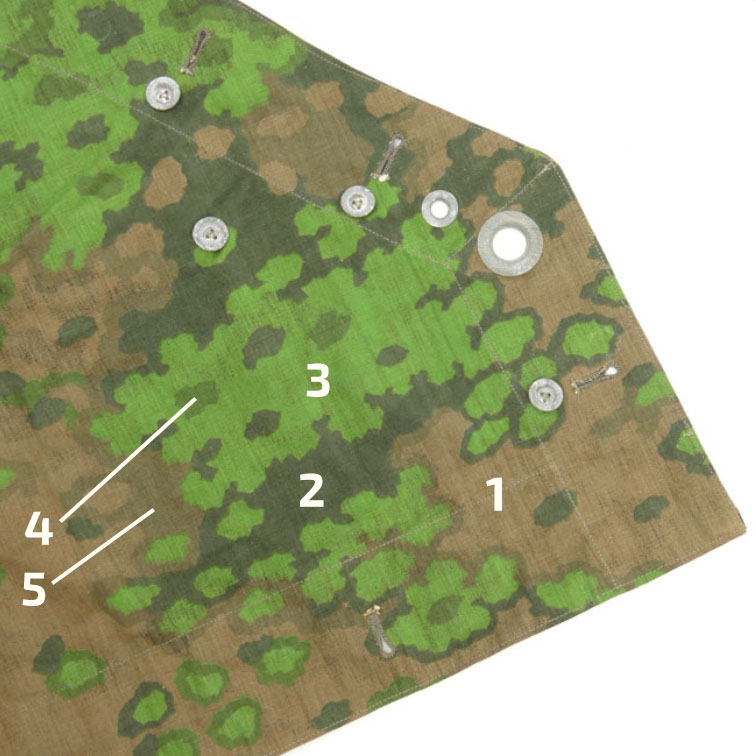
Colors of camouflage Oak: 1 - ground, 2 - black shadow, 3 - bright foliage, 4, 5 - additional shadows. Photo of originals from: militariaplaza.nl
The size of the camouflage scheme was 1.3x0.5 meters (here I do not give accurate data). The original size was dictated by the size of the Zeltbahn 1931 cape-tent so as not to be repeated on one canvas. From all sides, the scheme was docked on itself. The docking on the long (horizontal) side was invisible, but on the short side (vertical, where the Zeltbahn tent had a central seam) the docking passed through a series of stretched spots that strike the eye. After turning and hemming the central seam on the tent, the camouflage scheme would dock along this seam. And long noticeable spots were well detected by the cutter and provided a margin for the tuck.
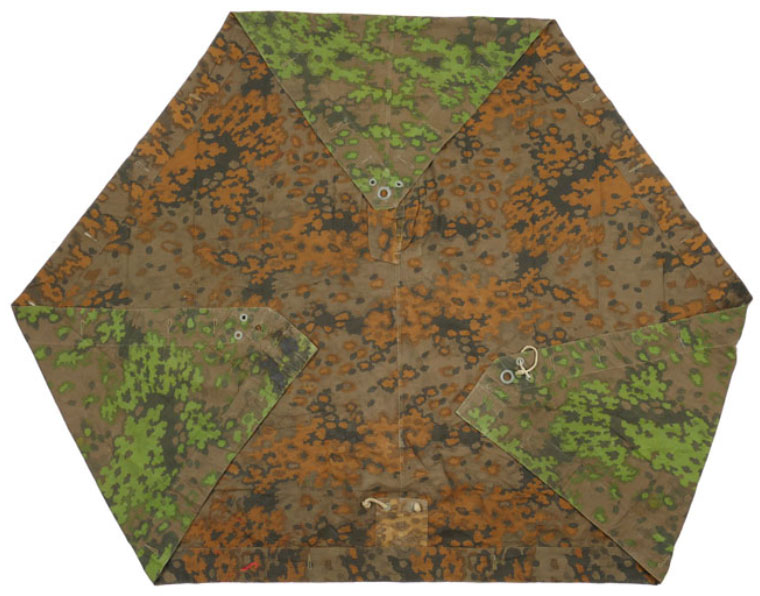
SS Oakleaf Zeltbahn, sewn correctly (qualitatively): the camouflage pattern is joined along the central seam, the entire product (with rare exceptions) is made of fabric from one batch. Photo of originals from: militariaplaza.nl
The further development of camouflage clothing left its mark on this rational idea. The usual width of the fabric for sewing clothes is 1.5 meters. Measuring the length of the camouflage pattern, it can be assumed that the Germans used 1.6 meters fabric. The Germans did not change the camouflage pattern of Oak for clothes (making the docking on the short side less noticeable). They just looped the circuit to the side, making it wider. A talented cutter could avoid noticeable docking spots in the cut in a prominent place. But most of the SS uniforms were sewn by the Nazi prisoners — slave workers, and they didn't make the best quality in the concentration camps. Therefore, often on the trouser-leg or on the chest, you can see a vertical line of identical spots — the Oak camouflage is joined vertically. Moreover, Zeltbahn tents also began to be made of wide fabric (the production of narrow fabric at that time no longer made economic sense). They also were cut incorrectly: as a result, two vertical stripes and no docking of spots along the central seam...
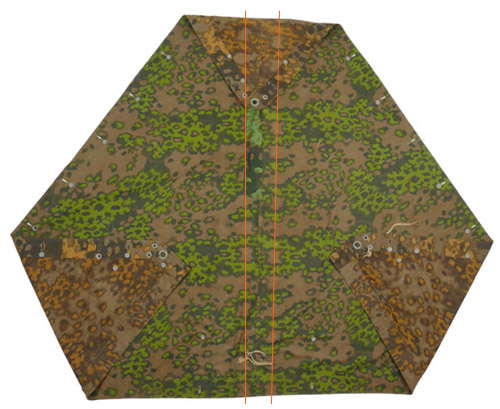
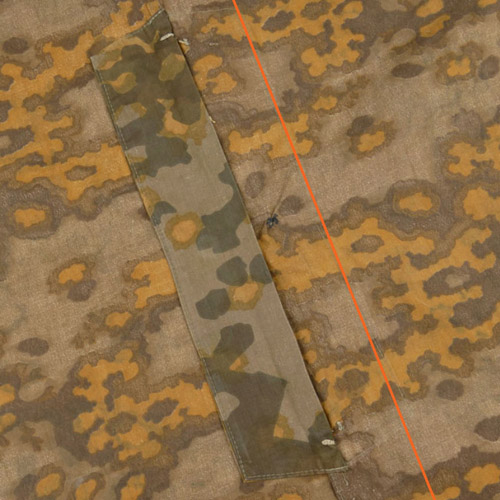
Left and right: SS Zelt in Oak camouflage, produced not earlier than 1941 from a wide fabric and in violation of the rules for cutting this camouflage fabric. Orange lines indicate the vertical joints of the pattern; they should be clearly along the central seam. The photo on the right shows that for the details of the collar used trimmed Platan fabric based on Oak of the same shade. Photo of originals from: militariaplaza.nl
Camouflage was printed using a machine method — a method that remained standard in the production of printed fabrics through the twentieth century. The machine consists of a series of cylindrical shafts, each bears its own color. Through them, with the help of a motor, a white (less often one-colored fabric) is stretched, and each shaft imprints its color on it. The result is a multi-color pattern.
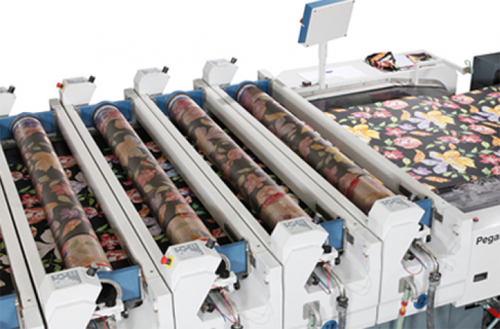
Pegasus EVO fabric printing machine. Photo from: spgprints.com
Printing each batch of camouflage was a kind of experiment, it must be remembered that no one in the world had done this at that time. Therefore, each batch of the same camouflage had slight color differences. Towards the end of the war (1944), the economic situation became very difficult; in particular, there were not enough dyes, because of which the color of the helmets, for example, lost its green hue and turned greenish-gray. In addition, the Allied bombers upset the economic mechanism, destroying either the factory or the warehouse. Because of this, the print runs of printed fabric (camouflage) have become smaller and the color spectrum wider. This can be seen in the products of the end of the war, which are sewn from pieces of camouflage of different colors and even from different camouflages. In camouflage, there was more defects: shifts, dirt.
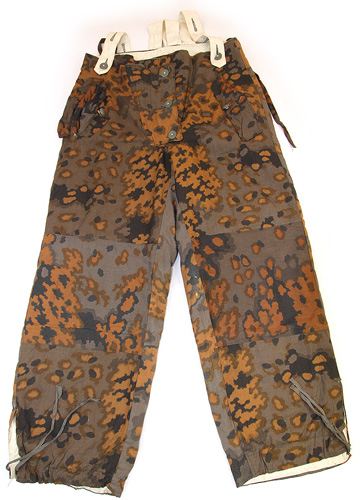
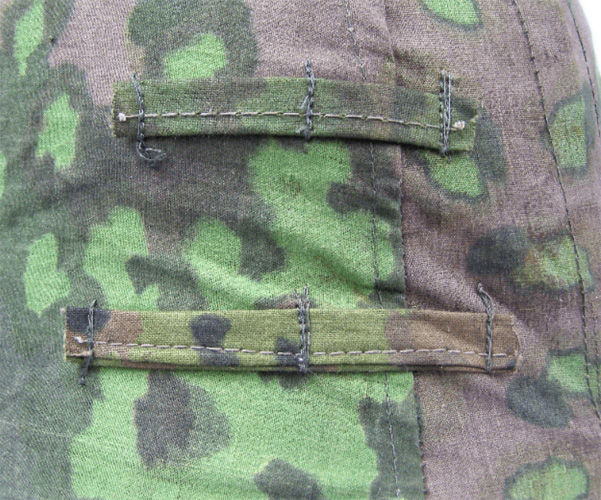
Left: SS winter pants are made from pieces of camouflage fabric. Oakleaf fabric in different colors (from different lots). Right: loops for holding grass on the SS helmet cover are made of different shades of Oak camo (scraps of another batch). Photo of originals from: militariaplaza.nl
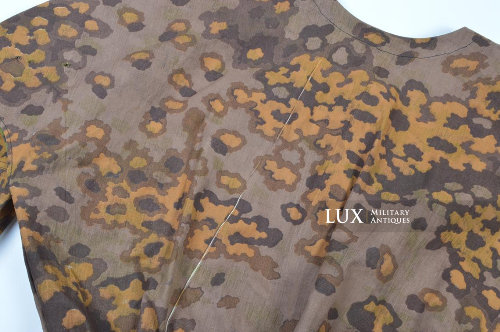
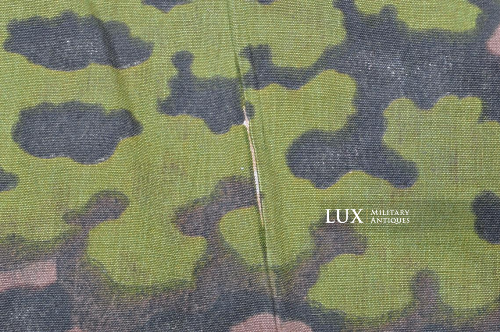
Fabric dye defect: the fabric passed all the shafts with a fold and there was a white stripe. SS blouse was sewn from this fabric. Photo of originals from: lux-military-antiques.com
In 1943, the variation of the Oakleaf camouflage appeared, collectors designate it with letter B. Oak-B was a redesigned Oak-A, the general layout and location of the spots remained the same, but some little things were changed. A distinctive feature of Oak-B is a thin dark edge of some spots, which is not in Oak-A.
Borsarello also distinguishes Oak-C, which is very similar to Oak-B. Of course, there are differences in them. However, it can be assumed that the development of another version was caused not so much by the camouflage development as by the production routine. If the shafts were damaged (for example, as a result of bombardment or inaccurate storage, transportation), then it was necessary to create new ones. In the difficult time of the end of the war, they were repaired or reproduced in haste, possibly without clear drawings in sight, and it caused differences in details.
Author: Anton Volchkov
© Online shop "Replika".
Copying is allowed only with reference to the source.









